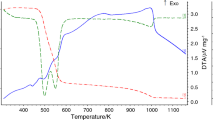Abstract
The reaction of barium(II) hydroxide with 2-furoic acid (pyromucic acid, Hfur) gave 1D coordination polymer {[Ba3(fur)6(Hfur)2(H2O)8]}n·4nH2O (I). According to X-ray diffraction data, I contains two symmetrically independent barium cations, which have different environments: Ba(1) coordinates six fur– anions, while Ba(2) is a fragment of heteroleptic coordination (fur–, Hfur, and H2O) (CIF file CCDC no. 2063380). The supramolecular polymeric architecture of I is determined by bridging water molecules and numerous hydrogen bonds between coordinated and solvation water molecules to form a 1D motif. The arrangement of Ba2+ ions in the trinuclear moiety {Ba3(fur)6(Hfur)2(H2O)8} of the polymer is nearly linear. The thermal behavior of I, investigated by simultaneous thermal analysis (argon atmosphere), showed a stepwise character of thermal decomposition caused by gradual destruction of the hydrogen-bonded framework and the subsequent partial destruction of the organic part. Analysis of the biological activity of I against the non-pathogenic Mycolicibacterium smegmatis strain showed low sensitivity of the bacterial wall to the complex.




Similar content being viewed by others
REFERENCES
K. D. A. Dimé, H. Cattey, D. Lucas, and Ch. H. Devillers, Eur. J. Inorg. Chem. 2018, 4834 (2018). https://doi.org/10.1002/ejic.201801142
J. Bhattacharjee, A. Harinath, A. Sarkar, and T. K. Panda, ChemCatChem 11, 3366 (2019). https://doi.org/10.1002/cctc.201900920
S. Nandi, Ph. Luna, R. Maity, et al., Mater. Horiz. 6, 1883 (2019). https://doi.org/10.1039/C9MH00133F
B. Paluchowska, J. K. Maurin, and J. Leciejewicz, J. Chem. Crystallogr. 27, 177 (1997). https://doi.org/10.1007/BF02575986
J. Yang, Yin Xin, Wu Le, et al., Inorg. Chem. 57, 150105 (2019). https://doi.org/10.1021/acs.inorgchem.5b00113
Wan Ke-Ke, Yu Jie-Hui, Yang Qing-Feng, et al., Eur. J. Inorg. Chem. 3094 (2019). https://doi.org/10.1002/ejic.201900558
H. Roueindeji, A. Ratsifitahina, and T. Roisnel, Chem. - Eur. J. 25, 8854 (2019). https://doi.org/10.1002/chem.201901262
T. Maity and D. Saha, S. Das, et al., Eur. J. Inorg. Chem. 30, 4914 (2012). https://doi.org/10.1002/ejic.201200417
X. Xu, F. Hu, and Q. Shuai, New J. Chem. 41, 13319 (2017). https://doi.org/10.1039/C7NJ03046K
W. Su, Y. Shi, X. Hao, et al., Inorg. Chim. Acta 490, 29 (2019). https://doi.org/10.1016/j.ica.2019.02.037
F. Liu, Y. Xu, L. Zhao, et al., J. Mater. Chem. A 3, 21545 (2015). https://doi.org/10.1039/C5TA03680A
L. E. Kreno, K. Leong, O. K. Farha, et al., Chem. Rev. 112, 1105 (2012). https://doi.org/10.1021/cr200324t
J. H. Wang, M. Li, and D. Li, Chem. Sci. 4, 1793 (2013). https://doi.org/10.1039/C3SC00016H
J. Xiao, Y. Wu, M. Li, et al., Chem. - Eur. J. 19, 1891 (2013). https://doi.org/10.1002/chem.201203515
D. A. Murav’eva, I. A. Samylina, and G. P. Yakovleva, Pharmacognosy (Meditsina, Moscow, 2007) [in Russian].
E. Bartolome, J. Bartolome, S. Melnic, et al., Dalton Trans. 43, 10999 (2014). https://doi.org/10.1039/C4DT00538D
P. H. Bhargao and B. R. Srinivasan, J. Coord. Chem. 72, 2599 (2019). https://doi.org/10.1080/00958972.2019.1666980
G. M. Sheldrick, Acta Crystallogr., Sect. A 71, 3 (2015). https://doi.org/10.1107/S2053273314026370
O. V. Dolomanov, L. J. Bourhis, R. J. Gildea, et al., J. Appl. Crystallogr. 42, 339 (2009). https://doi.org/10.1107/S0021889808042726
S. F. Chabira and M. Sebaa, Rev. Sci. Technol. Synthèse 24, 44 (2012).
O. B. Bekker, D. N. Sokolov, O. A. Luzina, et al., Med. Chem. Res. 24, 2926 (2015). https://doi.org/10.1007/s00044-015-1348-2
I. A. Lutsenko, D. S. Yambulatov, M. A. Kiskin, et al., Chem. Select 5, 11837 (2020). https://doi.org/10.1002/slct.202003101
I. A. Lutsenko, D. E. Baravikov, M. A. Kiskin, et al. Russ. J. Coord. Chem. 46, 411 (2020). https://doi.org/10.1134/S1070328420060056
I. A. Lutsenko, D. S. Yambulatov, M. A. Kiskin, et al., Russ. J. Coord. Chem. 46, 787 (2020). https://doi.org/10.1134/S1070328420120040
I. A. Lutsenko, M. A. Kiskin, K. A. Koshenskova, et al. Russ. Chem. Bull. 70, 463 (2021). https://doi.org/10.1007/s11172-021-3109-3
ACKNOWLEDGMENTS
X-ray diffraction analysis of compound I was carried out using the equipment of the Center for Molecular Structure Studies of the Nesmeyanov Institute of Organoelement Compounds, Russian Academy of Sciences, and was supported by the Ministry of Science and Higher Education of the Russian Federation. Elemental analysis, STA, and IR spectroscopy were carried out using the equipment of the Center for Collective Use of Physical Methods of Investigation of the Kurnakov Institute of General and Inorganic Chemistry, Russian Academy of Sciences, which is supported by the state assignment for the Kurnakov Institute of General and Inorganic Chemistry, Russian Academy of Sciences in the field of fundamental research.
Funding
This study was performed within the state assignment for the Kurnakov Institute of General and Inorganic Chemistry, Russian Academy of Sciences in the field of fundamental research and programs of the Russian Academy of Sciences. X-ray diffraction analysis of compound I was supported by the by the Ministry of Science and Higher Education of the Russian Federation and was done using the equipment of the Center for Molecular Structure Studies of the Nesmeyanov Institute of Organoelement Compounds, Russian Academy of Sciences.
Author information
Authors and Affiliations
Corresponding author
Ethics declarations
The authors declare that they have no conflicts of interest.
Additional information
Translated by Z. Svitanko
Supplementary Information
Rights and permissions
About this article
Cite this article
Nikiforova, M.E., Lutsenko, I.A., Kiskin, M.A. et al. Coordination Polymer of Ba2+ with 2-Furoic Acid Anions: Synthesis, Structure, and Thermal Properties. Russ. J. Inorg. Chem. 66, 1343–1349 (2021). https://doi.org/10.1134/S0036023621090102
Received:
Revised:
Accepted:
Published:
Issue Date:
DOI: https://doi.org/10.1134/S0036023621090102




